
Medical Importance of Rabies Virus
Learn about rabies, a viral disease transmitted through the bites of infected animals. Explore the route of infection, pathogenicity, symptoms, prevention methods, treatment options, and control measures for this potentially fatal disease.
Download Presentation

Please find below an Image/Link to download the presentation.
The content on the website is provided AS IS for your information and personal use only. It may not be sold, licensed, or shared on other websites without obtaining consent from the author. If you encounter any issues during the download, it is possible that the publisher has removed the file from their server.
You are allowed to download the files provided on this website for personal or commercial use, subject to the condition that they are used lawfully. All files are the property of their respective owners.
The content on the website is provided AS IS for your information and personal use only. It may not be sold, licensed, or shared on other websites without obtaining consent from the author.
E N D
Presentation Transcript
SERMINER PRESENTATION BY TUESIMI CINDERELLA 15/SCI05/015 MEDICAL IMPORTANCE OF VIRUS RABISE
WHAT IS RABIES? Rabies is a viral disease that is spread through the bite of infected animals It is caused by rabies virus, lyssa-virus and Australian bat virus Rabies is a viral disease that causes inflammation of the brain in humans and other mammal Rabies is spread when infected animals scratches or bites another animal or human
ROUTE OF INFECTION Saliva touching an open wound Animals to humans: scratches, bites Humans to humans: transplant surgery, sexual intercourse
PATHOGENICITY OF RABIES Rabies is a central nervous system (CNS) disease that is almost invariably fatal. The causative agent is rabies virus (RV), a negative-stranded RNA virus of the rhabdovirus family. ... A key factor in the neuroinvasion of RV is transsynaptic neuronal spread.
SYMPTOMS Fever Headache Inflammation of the brain Anxiety Paralysis Insomnia Confusion Hydrophobia Coma
PREVENTION Vaccinating dogs, cats, and ferrets against rabies Keeping pets under supervision Not handling wild animals or strays Contacting an animal control officer upon observing a wild animal or a stray, especially if the animal is acting strangely If bitten by an animal, washing the wound with soap and water for 10 to 15 minutes and contacting health care
TREATMENT Thoroughly washing the wound Applying alcohol Vaccination(human rabies immunoglobin)
CONTROL MEASURES Induced coma





















